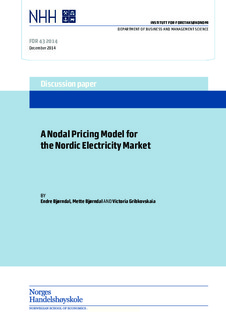A Nodal Pricing Model for the Nordic Electricity Market
Working paper

Åpne
Permanent lenke
http://hdl.handle.net/11250/273333Utgivelsesdato
2014-12Metadata
Vis full innførselSamlinger
- Discussion papers (FOR) [566]
Sammendrag
In the Nordic day-ahead electricity market zonal pricing or market splitting is used for relieving congestion between a predetermined set of bidding areas. This congestion management method represents an aggregation of individual connection points into bidding areas, and flows from the actual electricity network are only partly represented in the market clearing. Because of several strained situations in the power system during 2009 and 2010, changes in the congestion management method have been considered by the Norwegian regulator. In this paper we discuss nodal pricing in the Nordic power market, and compare it to optimal and simplified zonal pricing, the latter being used in today’s market. A model of the Nordic electricity market is presented together with a discussion of the calibration of actual market data for four hourly case studies with different load and import/exports to the Nordic area. The market clearing optimization model incorporates thermal and security flow constraints. We analyze the effects on prices and grid constraints and quantify the benefits and inefficiencies of the different methods. We find that the price changes with nodal pricing may not be dramatic, although in cases where intra-zonal constraints are badly represented by the aggregate transfer capacities in the simplified zonal model the nodal prices may be considerably higher on average and vary more than the simplified zonal prices. On the other hand nodal prices may vary less than the simplified zonal prices if aggregate transfer capacities are set too tightly. Allowing for more prices in the Nordic power market would make dealing with capacity limits easier and more transparent.